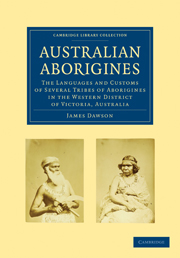 Australian Aborigines
Australian Aborigines Book contents
- Frontmatter
- PREFACE
- INTRODUCTORY NOTE
- Contents
- YARRUUN PARPUR TARNEEN
- CHAPTER I TRIBES
- CHAPTER II POPULATION
- CHAPTER III CHIEFS
- CHAPTER IV PROPERTY
- CHAPTER V CLOTHING
- CHAPTER VI HABITATIONS
- CHAPTER VII CLEANLINESS
- CHAPTER VIII DOMESTIC FURNITURE
- CHAPTER IX COOKING AND FOOD
- CHAPTER X TOOLS
- CHAPTER XI LAWS OF MARRIAGE
- CHAPTER XII CHILDREN
- CHAPTER XIII NAMES OF PERSONS
- CHAPTER XIV SUPERSTITIONS AND DISEASES
- CHAPTER XV DEATH AND BURIAL
- CHAPTER XVI AVENGING OF DEATH
- CHAPTER XVII GREAT MEETINGS
- CHAPTER XVIII AMUSEMENTS
- CHAPTER XIX WEAPONS
- CHAPTER XX ANIMALS
- CHAPTER XXI METEOROLOGY, ASTRONOMY, ETC
- CHAPTER XXII NATIVE MOUNDS
- CHAPTER XXIII ANECDOTES
- CONVEYANCE, BY PRINCIPAL CHIEFS TO JOHN BATMAN, OF 100,000 ACRES OF LAND, BETWEEN GEELONG AND QUEENSCLIFF
- VOCABULARIES.—WORDS; ANIMALS; RELATIONSHIPS; NAMES OF PLACES; GRAMMAR AND SENTENCES; NUMERALS
- NOTES
- Frontmatter
- PREFACE
- INTRODUCTORY NOTE
- Contents
- YARRUUN PARPUR TARNEEN
- CHAPTER I TRIBES
- CHAPTER II POPULATION
- CHAPTER III CHIEFS
- CHAPTER IV PROPERTY
- CHAPTER V CLOTHING
- CHAPTER VI HABITATIONS
- CHAPTER VII CLEANLINESS
- CHAPTER VIII DOMESTIC FURNITURE
- CHAPTER IX COOKING AND FOOD
- CHAPTER X TOOLS
- CHAPTER XI LAWS OF MARRIAGE
- CHAPTER XII CHILDREN
- CHAPTER XIII NAMES OF PERSONS
- CHAPTER XIV SUPERSTITIONS AND DISEASES
- CHAPTER XV DEATH AND BURIAL
- CHAPTER XVI AVENGING OF DEATH
- CHAPTER XVII GREAT MEETINGS
- CHAPTER XVIII AMUSEMENTS
- CHAPTER XIX WEAPONS
- CHAPTER XX ANIMALS
- CHAPTER XXI METEOROLOGY, ASTRONOMY, ETC
- CHAPTER XXII NATIVE MOUNDS
- CHAPTER XXIII ANECDOTES
- CONVEYANCE, BY PRINCIPAL CHIEFS TO JOHN BATMAN, OF 100,000 ACRES OF LAND, BETWEEN GEELONG AND QUEENSCLIFF
- VOCABULARIES.—WORDS; ANIMALS; RELATIONSHIPS; NAMES OF PLACES; GRAMMAR AND SENTENCES; NUMERALS
- NOTES
Summary
The natives have few tools; the principal one is the stone axe, which resembles the stone celts found in Europe. This useful and indispensable implement is of various sizes. It is made chiefly of green stone, shaped like a wedge, and ground at one end to a sharp edge. At the other end it is grasped in the bend of a doubled piece of split sapling, bound with kangaroo sinews, to form a handle, which is cemented to it with a composition of gum and shell lime. This cement is made by gathering fresh wattle gum, pulling it into small pieces, masticating it with the teeth, and then placing it between two sheets of green bark, which are put into a shallow hole in the ground, and covered up with hot ashes till the gum is dissolved. It is then taken out, and worked and pulled with the hands till it has become quite stringy, when it is mixed with lime made of burnt mussel shells, pounded in a hollow stone—which is always kept for the purpose—and kneaded into a tough paste. This cement is indispensable to the natives in making their tools, spears, and water buckets. The stone axe is so valuable and scarce that it is generally the property of the chief of the tribe. He lends it, however, for a consideration, to the best climbers, who use it to cut steps in the bark of trees, to enable them to climb in search of bears, opossums, birds, and nests, and also to cut wood and to strip bark for their dwellings.
- Type
- Chapter
- Information
- Australian AboriginesThe Languages and Customs of Several Tribes of Aborigines in the Western District of Victoria, Australia, pp. 24 - 25Publisher: Cambridge University PressPrint publication year: 2009First published in: 1881


